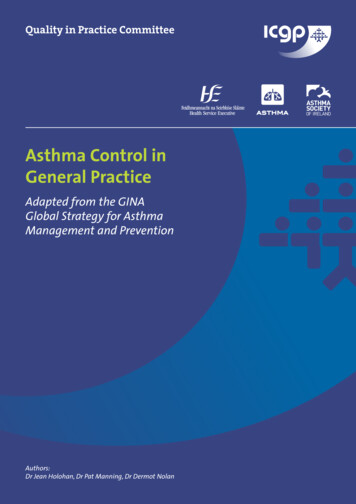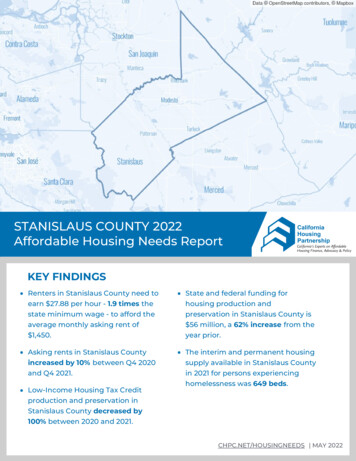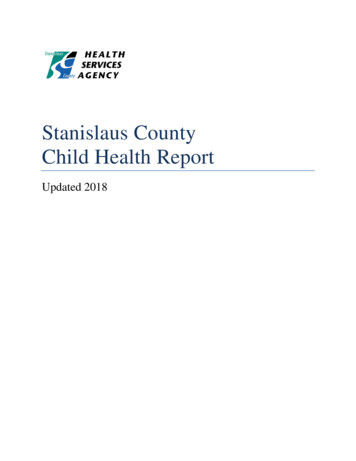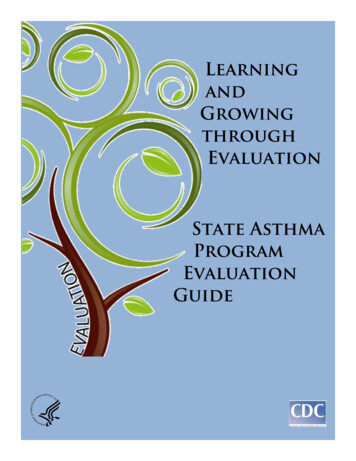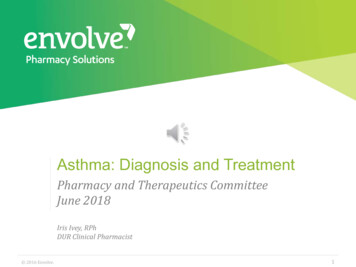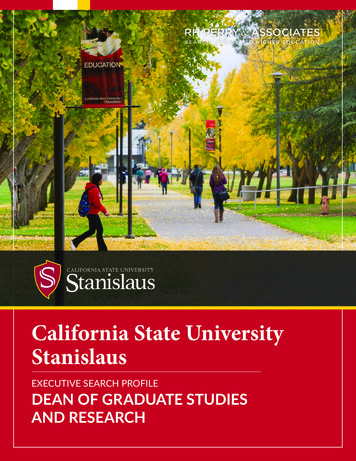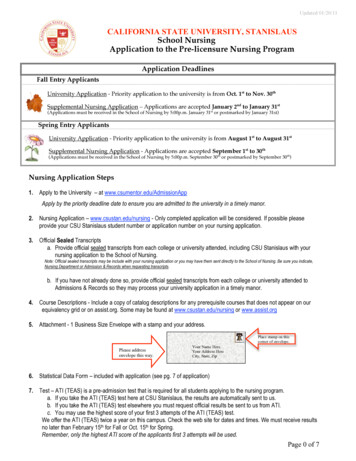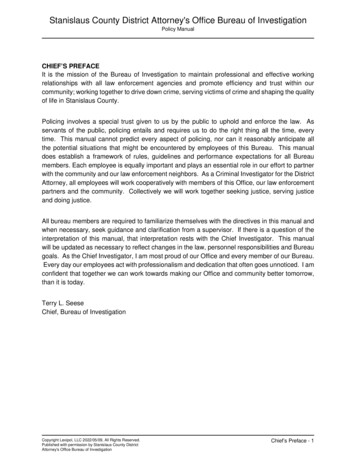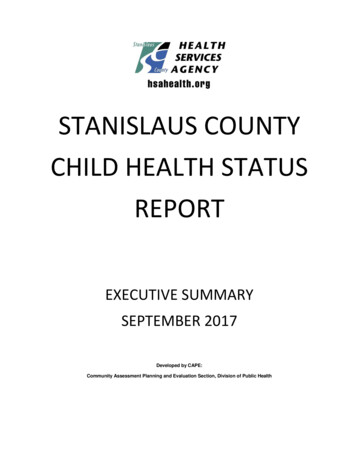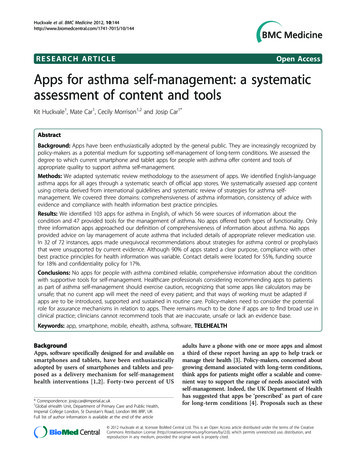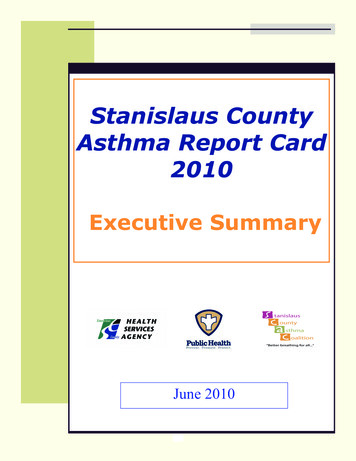
Transcription
Stanislaus CountyAsthma Report Card2010Executive SummaryJune 2010
AcknowledgementsThe development of this report was supported in part by the California Asthma PublicHealth Initiative (CAPHI) and the California Department of Public Health (CDPH) with funding from the Cigarette and Tobacco Products Surtax Fund (Prop 99) Unallocated Account(UA). Stanislaus County is the recipient of an Enhancing Local Capacity to Address AsthmaPriorities (ELCAAP) Program grant from CDPH for 2009-2012 and used ELCAAP funds, inpart, to create this report.In addition, technical assistance was received from state epidemiologists from the California Breathing project of the California Department of Public Health’s EnvironmentalHealth Investigations Branch. This report is modeled after the county asthma profiles produced by California Breathing, but includes more county-specific and sub-county information than those reports. Readers may wish to refer to these or other publications producedby California Breathing which can be found at http://www.californiabreathing.org/.Finally, the Central Valley Health Policy Institute (at CSU Fresno) provided assistancewith obtaining and analyzing data not available directly to county staff.The Stanislaus County Asthma Coalition, particularly its subcommittee, played a keyrole in designing the focus of and helping collect survey data for this report.A special thank you is due to the following Stanislaus County Health Services Agency/Public Health staff for their contribution to the publication of this document:Dolores CisnerosSharon HutchinsPhoebe LeungCleopathia Moore-BellOlivia TongJoseph Wadley*************Stanislaus County Board of SupervisorsJeff Grover, Chairman, District ThreeDick Monteith, Vice-Chairman, District FourWilliam O’Brien, District OneVito Chiesa, District TwoJim DeMartini, District FiveHealth Services Agency, Public Health AdministrationMary Ann Lee, Managing Director, HSACleopathia Moore-Bell, Associate Director, Director of Public Health ServicesJohn Walker, M.D., Public Health Officer, Stanislaus CountyNancy Fisher, Assistant Director, Director of NursingPhoebe Leung, Assistant Director, Public Information Officer
IntroductionNational and State ContextAsthma is a serious and chronic health condition affecting the lungs, whose ultimatecauses are not completely understood (NIH, 2010). Asthma is one of the most commonchronic diseases in childhood, and is responsible for a large amount of school and work absenteeism (CDC, 2006). Lifetime asthma prevalence (for both children and adults) has beengenerally rising nationally (e.g. US EPA, 2010, based on data from the National Health Interview Survey) and in California (e.g. CDC, 2008, based on Behavioral Risk Factor SurveillanceSystem data). California falls generally in the upper (worse) half of US states in its asthmaprevalence (see the graph below).Percent of Residents EverDiagnosed with AsthmaLifetime Asthma Prevalence in California vs. US*2000-2008201510CaliforniaUS*595%CI CA LLforCACA UL02000 2001 2002 2003 2004 2005 2006 2007 2008YearsSource: Behavioral Risk Factor Surveillance Survey Data, CDC*US value is median of 50 states and Washington DC. 95% CI 95% Confidence Interval for California data points. See Technical Notes .Outdoor air qualityplays a role in California’sasthma burden. ElevenCalifornia MetropolitanStatistical Areas and 18California counties areamong the 25 worse inthe nation for at least onepollutant category.Stanislaus County ranksas the 20th most pollutedUS county (out of 3,141counties) based on shortterm particle pollution,while the capital, Modesto,ranks 17th worse amongUS Metropolitan StatisticalAreas (ALA, 2009).Health DisparitiesAfter several decades, researchers now understand that one’s socioeconomic statusplays a large role in one’s health (e.g. Brennan Ramirez et al, 2008). Asthma, and factors contributing to it, do not affect everyone equally. Some people—by reasons of genetics, general health, behavior, social status, income, geographic location, occupation orenvironment—are more likely to have asthma or suffer severe consequences of asthma.Such differences across sub-groups of people are called health inequities or health disparities. Some people (e.g. CDC, June 2010) reserve the term health disparity for situations in which the health differences are unfair and due to prejudice or the unjust distribution of resources. However, in this report, health disparity will be used in the moregeneral sense of any difference in health status or outcomes across different groups.Stanislaus County exhibits many health disparities related to asthma and the factorsthat contribute to it. Important differences among sub-groups must be understood whendesigning interventions to reduce asthma, its risk factors and consequences. Therefore,this report highlights health disparities to enable policy makers and those working tomake Stanislaus County healthier to know where and on whom to focus particular programs to make the largest impact on the county’s health.1
Major FindingsStanislaus vs. CaliforniaThe burden of asthma in Stanislaus County is heavier than that of the state as a wholein several ways. First, a statistically significantly higher percentage of county residentswith lifetime asthma (i.e. ever diagnosed with asthma) report having experienced symptoms in the past year (79% vs. 66%; see graph at left). Second, a statistically significantlylarger percentage of Stanislaus County residents with lifetime asthma report having experienced symptoms in the past year (79% vs. 66%). Third, a statistically significantly higherpercentage of county residents with active asthma (i.e. have a current diagnosis ofasthma), report having had at least one asthma attack in the past year (44% vs. 33%; seegraph at right). Fourth, the annual (age-adjusted) mortality rate from asthma is higher inStanislaus County (13.9 deaths per million residents) than California (12.9) or the US(12.0). Between 2005-2007, Stanislaus residents who died from asthma did so at a meanof 63.0 years of age. Thus, on average, people who died of asthma lost 15.5 years of potential life compared to the standard life length of 75 years. For the time period 20052007, a cumulative of 310 years of potential life was lost due to asthma in the county.Percentage of Active Asthmaticswith Asthma Attack in Past Year201513.712.0Percentage of those withActive AsthmaPercent of Residents EverDiagnosed with AsthmaAsthma Prevalence in Stanislaus vs.California, forniaStanislaus 95% slaus60California402043.7 32.956.3 67.1YesNo0Asthma Attack in Past YearYearsSource: California Health Interview Survey, 2005 & 2007.Note: Error bars indicate the 95% Confidence Interval(see Technical Notes).Source: California Health Interview Survey. See TechnicalNotes for information about confidence intervals.Stanislaus County also differs from the state of California in the distribution ofasthma among individuals of different demographic characteristics. Notably, more females overall in Stanislaus County have been diagnosed with asthma than males( 41,000 vs. 24,000), and this difference is true for each age group (children, workingage adults and seniors). In California (and the nation as a whole), however, more malechildren and teens have ever been diagnosed with asthma than females in these agegroups, while more adult women have been diagnosed with asthma than adult men.The county’s heavier burden of asthma symptoms, attacks and deaths due to asthmamay be the result of greater exposure to asthma triggers (e.g. outdoor air pollution, indoor cleaning agents, dust or pests), less effective self-management and/or medical control of the condition, reduced access to health insurance and healthcare, or other factors.2
Asthma Management and TreatmentPercentage of RespondentsSelf-Management: Individuals living with asthma can help manage their condition.Doing so requires awareness of asthma triggers and how to reduce exposure to them, aswell as how to comply with medical recommendations. Findings from a local survey conducted by Stanislaus County Health Services Agency / Public Health (Public Health) in2010, indicate that many county residents are unaware of how to control their exposureto asthma-causing agents or triggers. For example, only 49% of respondents reportedknowing how to find thedaily Air Quality IndexKnow How to Find AQI by Understanding of(AQI) rating that couldMeaning of Asthma Flagshelp them limit their exposure to poor quality air.However, those who re75%Understandported being aware of theMeaning ofAsthma Flag Program run50%Asthmaby the Stanislaus CountyFlagsAsthma Coalition (in which25%Yesschools, government of57.3% 37.7%42.7% 62.3%fices and other facilities flyNo0%colored flags to indicateAgree or StronglyDisagree or Stronglythe air quality) and reAgreeDisagreeported understanding themeaning of the flag’s colAgreement with statement "I know how toors were statistically sigfind the AQI rating each day"nificantly more likely toSource: Asthma and Air Quality Awareness Survey, Stanislausreport knowing how to findCounty Health Services Agency / Pub lic Health, 2010the AQI value.Self-management requires understanding and complying with medical recommendations. Just over 40% of Stanislaus residents with active asthma have been prescribed adaily controller medication. However, over half of such individuals reported (in a localsurvey) believing that that they do not have to take daily asthma medication when theyfeel good, while 41% thought they only needed to see a doctor when they feel bad.These responses indicate a lack of awareness about asthma and its medical control andtreatment and suggest that most Stanislaus County residents with asthma may benefitfrom discussion with their health care provider about how to control this condition.Institutional and Policy Support: Schools, child care facilities and workplaces, wherechildren and adults spend much of their waking hours, can assist asthma sufferers tolimit their exposure to potential asthma triggers. Increasingly, Stanislaus County schoolsand school districts have asthma management plans in place, and encourage or requirethe registration of individual Asthma Action Plans (AAPs) for students with asthma. Additionally, a total of 190 of the 254 schools in the county participate in the Asthma FlagProgram mentioned above. In a recent survey of child care facility operators, PublicHealth and the Asthma Coalition found that over half of the responding facilities have anasthma policy or procedure in place while two-thirds of facilities require an AAP for allchildren with asthma. Larger commercial, center-based child care facilities are morelikely to have an asthma policy and require AAPs than other types of child care facilities.3
Medical Management and Treatment: Healthcare providers are not required to reportdiagnoses of asthma to public health authorities under Title 17 of the California Healthand Safety code, making detailed information on the medical treatment and managementof asthma difficult to obtain. However, one large clinic system in Stanislaus County voluntarily provided aggregated information about care for asthma patients during 12month period for this report. Only one-third of asthma patients received an influenza immunization during the previous 12 months (as recommended by CDC) and only 20%were given a severity assessment at their last visit. Still fewer were asked about symptom-free days, ER/urgent care visits, absenteeism from school or work, and exposure toenvironmental tobacco smoke or other asthma triggers, or had an asthma self-management goal set within the previous year. It is important to take into account that patientsnot receiving screenings or assessments during this time period may have had them during earlier time periods, and that not all visits received during this time period may havebeen due to asthma-related concerns. However, despite these limitations, the data showthat asthma treatment and management can be improved in Stanislaus County.Health DisparitiesRate per 10,000 Residents*Race and Ethnicity: Racial and ethnic differences are common across health conditions. Asthma is no exception, with African Americans having the highest prevalence inthe US. The full Asthma Report Card documents disparities in the asthma burden on individuals of different racial and ethnic groups. Despite evidence that racial and ethnicminorities are less likely to have a regular source of medical care (and, thus, are lesslikely to be diagnosed with asthma), neither the prevalence of lifetime nor active asthmain Stanislaus Countydiffers statistically significantly by race orRate of Asthma ER Visits and Hospitalizationsethnicity. However,by Race/Ethnicity, 2005-2008the (age-adjusted)rate of asthma ER vis160its and hospitalizations137.4ER Visitare significantly higherHospitalization120for African Americansthan Whites (seegraph), indicating a8054.652.7higher burden of com33.2plications in this group.4028.117.5All the reasons for this11.311.26.56.6higher burden are not0known, though -economic status,AmericanIslanderco-morbidities, healthinsurance and healthRace/Ethnicitycare access all likely*Average rate per 10,000 residents, age-adjusted to the 2000 US standard population.ER visit and hospitalziation data from the CA Office of Statewide Health Planning andplay a significant role.Development. Population data from ESRI. Analysis provided by California Breathing,California Department of Public Health.4
Percentage of ResidentsDiagnosed with AsthmaIncome and Poverty: In Stanislaus County, as in California and the nation as awhole, individuals with lower incomes (especially those living under the Federal PovertyLevel) have a higher prevalence of active asthma than individuals with greater financialresources. These differences persist despite the fact that individuals of lower income areless likely to have regular access to a healthcare provider. Again, there are likely manyfactors contributingto this health disPrevalence of Active Asthma by Poverty Level andparity, includingJurisdiction, 2005-2007type of housing(and exposure toindoor asthma trig30Stanislausgers), occupation,Californiaand outdoor air20quality typically encountered. In addition, poverty is10more commonamong racial and17.6 8.36.8 7.912.0 8.87.9 8.10ethnic minorities,0 to 99%100-199%200-299%300 %indicating thatthese two variablesPercentage of Federal Poverty Levelmay work togetherSource: California Health Interview Survey, 2003, 2005 and 2007 combined. Analysisto increase the burconducted by California Breathing, California Department of Public Health. Note: Error barsden of asthma.represent the 95th Confidence Interval (See Technical Notes for more information).Geographic Location: Communities within Stanislaus Counties are impacted differently by asthma. These communities differ in a multitude of characteristics, includingthe proportions of younger vs. older individuals, the number of individuals of specificracial/ethnic and socioeconomic groups, common types of occupations, rates of healthinsurance among residents, risk of exposure to various indoor and outdoor asthmatriggers and the proximity of medical facilities. Thus, it is difficult to determine whichfactors contribute most to the unequal asthma burdens across these communities. Inthe interest of preserving the unique character of various communities, the Countywas divided into 9 regions for the purposes of this report. Each of these regions isbased on zip code, has a Family Resource Center at its core, and is made up of communities that share some common features.The asthma burden, at least of ER visits and hospitalizations, is greatest in WestModesto, the Central part of the county (East Central Modesto and Airport Neighborhood), the South Central region (Ceres and Keyes) and the Northeast side (KnightsFerry, Oakdale, Riverbank and Valley Home). The North (Del Rio and Salida), South(Turlock), West (including Crows Landing, Grayson, Newman, Patterson and Westley)and Southeast (including Denair, Empire, Hickman, Hughson, La Grange and WaterStanislausCountyHispanicsareless likelytoof ER visits and hospitalizations.ford) sidesof the countyhavea lowerburden5
RecommendationsExpansion of Asthma Flag Program and Awareness of Air Quality: The Asthma Flag Program is a program sponsored by the Stanislaus County Asthma Coalition in which coloredflags are flown daily at schools and other public buildings to inform residents about airquality. Evidence was reviewed showing that the Asthma Flag Program is successful inproviding residents access to AQI information. The Stanislaus County Asthma Coalition,school boards and administrators, and managers of hospitals and clinics or other publicinstitutions should consider expanding participation in the asthma flag program.Media Campaign to Increase Awareness About Asthma Management and Control: Recentsurveys reviewed in this report revealed that a majority of Stanislaus County residentswith asthma misunderstand how to work with a healthcare provider to control theirasthma. A media campaign focused on effective self-management of asthma is warranted, particularly to encourage individuals to take medications as prescribed and regularly see a healthcare provider.Support for Initiatives to Improve Access to Healthcare: The 2008 Stanislaus CountyCommunity Health Assessment revealed many obstacles to effective asthma management in the county, including a large percentage of residents lacking health insurance, aregular source of care, and/or coverage for prescription medications (e.g. daily asthmacontrollers). These issues can lead to delay in diagnosis and treatment of asthma, whichin turn can lead to negative consequences ranging from work and school absenteeism(decreasing economic productivity and educational attainment), increased use of urgentcare facilities and emergency rooms, avoidable hospitalizations and preventable deaths.Additional Healthcare Provider Continuing Education Opportunities: The StanislausCounty Asthma Coalition conducts a Physician Roundtable annually, at which continuingeducation credits for physicians, nurses, and respiratory therapists are provided. Thefindings of this report on asthma prevalence, severe consequences and the medical treatment and control of asthma suggest that review of the usage of asthma managementplans, daily controller medications, and the diagnosis and treatment of asthma in veryyoung children would be productive future topics for this series.Expansion of Asthma Policies at Child Care Facilities, Schools and Work Settings:Findings from a recent local survey of child care facility operators revealed that nearlyhalf of the facilities surveyed do not have an asthma management plan to help reduceexposure to asthma triggers and promote effective response to an asthma-related emergency at the center. Stanislaus County Health Services Agency/Public Health, the Stanislaus County Asthma Coalition, the Stanislaus County Office of Education, and employerassociations may wish to consider increasing outreach to child care facilities as well asschools to help improve these environments to prevent and control asthma.Support for Initiatives to Improve Outdoor Air Quality: The poor air quality of the SanJoaquin Valley is a challenge to asthma prevention efforts and will continue to be so asthe population increases. Policy makers may also wish to explore ways to protect vulnerable populations, including children, from air pollution sources, such as restricting idlingof emergency and commercial vehicles, setting minimum distances between major roadways and newly built places where individuals spend a good deal of time, includingschools, childcare facilities and residences.6
The Stanislaus County Asthma Coalition, particularly its subcommittee, played a key role in designing the focus of and helping collect survey data for this report. A special thank you is due to the following Stanislaus County Health Services Agency/ Public Health staff for their contribution to the publication of this document:
